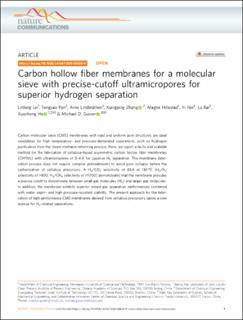| dc.contributor.author | Lei, Linfeng | |
| dc.contributor.author | Pan, Fengjiao | |
| dc.contributor.author | Lindbråthen, Arne | |
| dc.contributor.author | Zhang, Xiangping | |
| dc.contributor.author | Hillestad, Magne | |
| dc.contributor.author | Nie, Yi | |
| dc.contributor.author | Bai, Lu | |
| dc.contributor.author | He, Xuezhong | |
| dc.contributor.author | Guiver, Michael D. | |
| dc.date.accessioned | 2021-01-13T07:42:56Z | |
| dc.date.available | 2021-01-13T07:42:56Z | |
| dc.date.created | 2021-01-11T12:31:23Z | |
| dc.date.issued | 2021 | |
| dc.identifier.issn | 2041-1723 | |
| dc.identifier.uri | https://hdl.handle.net/11250/2722669 | |
| dc.description.abstract | Carbon molecular sieve (CMS) membranes with rigid and uniform pore structures are ideal candidates for high temperature- and pressure-demanded separations, such as hydrogen purification from the steam methane reforming process. Here, we report a facile and scalable method for the fabrication of cellulose-based asymmetric carbon hollow fiber membranes (CHFMs) with ultramicropores of 3–4 Å for superior H2 separation. The membrane fabrication process does not require complex pretreatments to avoid pore collapse before the carbonization of cellulose precursors. A H2/CO2 selectivity of 83.9 at 130 °C (H2/N2 selectivity of >800, H2/CH4 selectivity of >5700) demonstrates that the membrane provides a precise cutoff to discriminate between small gas molecules (H2) and larger gas molecules. In addition, the membrane exhibits superior mixed gas separation performances combined with water vapor- and high pressure-resistant stability. The present approach for the fabrication of high-performance CMS membranes derived from cellulose precursors opens a new avenue for H2-related separations. | en_US |
| dc.language.iso | eng | en_US |
| dc.publisher | Nature Research | en_US |
| dc.rights | Navngivelse 4.0 Internasjonal | * |
| dc.rights.uri | http://creativecommons.org/licenses/by/4.0/deed.no | * |
| dc.title | Carbon hollow fiber membranes for a molecular sieve with precise-cutoff ultramicropores for superior hydrogen separation | en_US |
| dc.type | Peer reviewed | en_US |
| dc.type | Journal article | en_US |
| dc.description.version | publishedVersion | en_US |
| dc.source.volume | 12 | en_US |
| dc.source.journal | Nature Communications | en_US |
| dc.identifier.doi | 10.1038/s41467-020-20628-9 | |
| dc.identifier.cristin | 1868896 | |
| dc.relation.project | Norges forskningsråd: 267615 | en_US |
| dc.description.localcode | Open Access This article is licensed under a Creative Commons Attribution 4.0 International License, which permits use, sharing, adaptation, distribution and reproduction in any medium or format, as long as you give appropriate credit to the original author(s) and the source, provide a link to the Creative Commons license, and indicate if changes were made. The images or other third party material in this article are included in the article’s Creative Commons license, unless indicated otherwise in a credit line to the material. If material is not included in the article’s Creative Commons license and your intended use is not permitted by statutory regulation or exceeds the permitted use, you will need to obtain permission directly from the copyright holder. To view a copy of this license, visit http://creativecommons.org/ licenses/by/4.0/. | en_US |
| cristin.ispublished | true | |
| cristin.fulltext | original | |
| cristin.qualitycode | 2 | |

